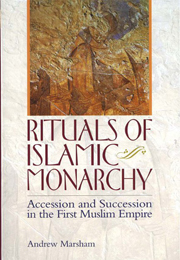Book contents
- Frontmatter
- Contents
- List of maps and figures
- Acknowledgements
- Map 1
- Map 2
- Map 3
- INTRODUCTION
- PART I LATE ANTIQUE ARABIA AND EARLY ISLAM (c. 550–c. 660)
- PART II THE UMAYYAD CALIPHATE (c. 660–750)
- INTRODUCTION
- 4 SUFYANID ACCESSION AND SUCCESSION, c. 660–683
- 5 THE OATH OF ALLEGIANCE IN THE EARLY TRADITION AND POETRY, c. 680–c. 710
- 6 THE MARWANID PATRIMONY AND DYNASTIC SUCCESSION
- 7 MARWANID RITUALS OF ACCESSION AND SUCCESSION
- 8 WRITING AND THE BAYcA IN THE MARWANID PERIOD
- 9 THE QURANIC CONTENT OF THE MARWANID DOCUMENTS
- PART III THE EARLY ABBASID CALIPHATE (c. 750–809)
- PART IV THE MIDDLE ABBASID CALIPHATE (809–865)
- CONCLUSION
- Genealogical table of Quraysh
- Genealogical table of the Abbasid caliphs
- Bibliography
- Index
7 - MARWANID RITUALS OF ACCESSION AND SUCCESSION
from PART II - THE UMAYYAD CALIPHATE (c. 660–750)
Published online by Cambridge University Press: 05 September 2013
- Frontmatter
- Contents
- List of maps and figures
- Acknowledgements
- Map 1
- Map 2
- Map 3
- INTRODUCTION
- PART I LATE ANTIQUE ARABIA AND EARLY ISLAM (c. 550–c. 660)
- PART II THE UMAYYAD CALIPHATE (c. 660–750)
- INTRODUCTION
- 4 SUFYANID ACCESSION AND SUCCESSION, c. 660–683
- 5 THE OATH OF ALLEGIANCE IN THE EARLY TRADITION AND POETRY, c. 680–c. 710
- 6 THE MARWANID PATRIMONY AND DYNASTIC SUCCESSION
- 7 MARWANID RITUALS OF ACCESSION AND SUCCESSION
- 8 WRITING AND THE BAYcA IN THE MARWANID PERIOD
- 9 THE QURANIC CONTENT OF THE MARWANID DOCUMENTS
- PART III THE EARLY ABBASID CALIPHATE (c. 750–809)
- PART IV THE MIDDLE ABBASID CALIPHATE (809–865)
- CONCLUSION
- Genealogical table of Quraysh
- Genealogical table of the Abbasid caliphs
- Bibliography
- Index
Summary
Because of the secondary, and very laconic and fragmentary, literary evidence for Marwanid rituals of accession and succession only a fraction of their symbolic resonances can now be glimpsed. However, when the texts are read alongside the material evidence for the architectural settings of rituals of accession and succession, and the evidence for the dress and regalia of the ruler, some sense of the form and meaning of these rituals can be gained. The two bay cas to Marwān I and Yazīd III, in 684 and 744 respectively, were remembered in more detail because they were of great political signifiance. Even in these cases, however, the rituals themselves are not discussed. In what follows, a general picture of the location of the ceremonial of Marwanid accession and succession, the sequence of events and participation in them is reconstructed. This is followed by a discussion of the physical appearance and regalia of the caliph, as reflected in the surviving Umayyad images of him.
LOCATION
Almost all Marwanid ceremonies of acclamation took place at a congregational mosque. From the outset of the foundation of a Muslim community the place of assembly for prayer had also been the main political forum and gathering-place. By the early eighth century, the congregational mosque had taken on a monumental character and had become part of a complex of governmental and administrative buildings at the centre of Arabian–Muslim settlements.
- Type
- Chapter
- Information
- Rituals of Islamic MonarchyAccession and Succession in the First Muslim Empire, pp. 134 - 144Publisher: Edinburgh University PressPrint publication year: 2009

